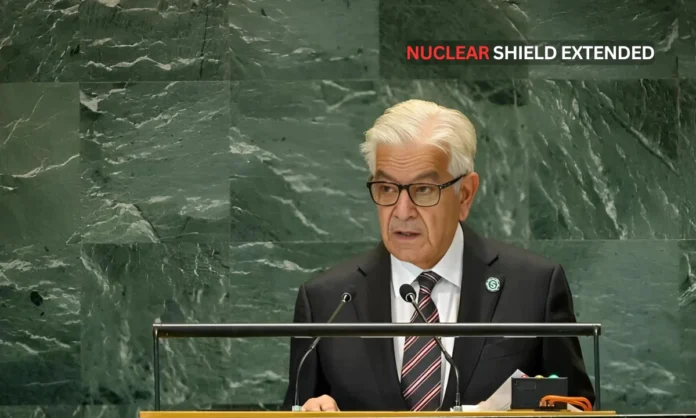Key Highlights:
- Pakistan’s 170-warhead nuclear arsenal will be accessible to Saudi Arabia under the comprehensive defense pact signed September 17, 2025
- The agreement establishes NATO-style collective defense where any attack on either nation triggers joint retaliation from both countries
- India has responded cautiously, stating it will study the pact’s implications for regional security while expecting Saudi Arabia to respect mutual interests
Pakistan’s Nuclear Umbrella Officially Extended
The Pakistan nuclear shield arrangement marks an unprecedented development in global nuclear policy, with Defense Minister Khawaja Asif explicitly confirming that Pakistan’s atomic capabilities will be shared with Saudi Arabia. Speaking to Geo TV, Asif declared that Pakistan’s nuclear deterrent capabilities, established through atomic tests in 1998, “will absolutely be available under this pact”. This represents the first time any nuclear-armed nation has formally placed another country under its atomic protection umbrella.

Global Nuclear Arsenal Comparison: Pakistan ranks 6th worldwide with 170 nuclear warheads, positioning it as a significant nuclear power in the Pakistan-Saudi defense agreement
Pakistan’s nuclear arsenal consists of approximately 170 warheads according to multiple international assessments, making it the world’s sixth-largest nuclear stockpile. The Pakistan nuclear shield extends to weapons with yields ranging from 5-12 kilotons for tactical systems to 40 kilotons for longer-range ballistic missiles. Pakistan’s nuclear doctrine traditionally focused exclusively on deterring India, but this agreement fundamentally expands the scope of Pakistani nuclear policy.
The mutual defense pact includes comprehensive military cooperation beyond nuclear sharing, with Saudi officials confirming the agreement “encompasses all military means”. This Pakistan nuclear shield arrangement effectively combines Pakistan’s atomic deterrent with Saudi Arabia’s substantial financial resources and regional influence.
Strategic Defense Agreement Mirrors NATO Framework
The Pakistan nuclear shield operates within a broader mutual defense framework explicitly modeled after NATO’s Article 5 collective defense mechanism. Defense Minister Asif emphasized that the agreement functions as a “defensive rather than offensive arrangement,” drawing direct parallels to NATO’s collective security model where an attack against one member constitutes an attack against all.

Timeline of Pakistan-Saudi Defense Relations: Key milestones leading to the historic nuclear shield agreement in September 2025
The Strategic Mutual Defense Agreement signed during Pakistani Prime Minister Shehbaz Sharif’s visit to Riyadh contains a crucial clause stating that “any aggression against either country shall be considered an aggression against both”. This Pakistan nuclear shield provision mirrors NATO’s Article 5, which has provided collective security for Western allies for over 70 years.
Unlike NATO’s deliberately ambiguous language that allows members flexibility in response options, the Pakistan-Saudi agreement appears more definitive in its mutual defense commitments. The Pakistan nuclear shield extends beyond conventional military cooperation to include Pakistan’s most sensitive strategic capabilities.
Regional Security Implications and Indian Response
India has responded with measured concern to the Pakistan nuclear shield arrangement, with the Ministry of External Affairs stating it will “study the implications of this development for our national security as well as for regional and global stability”. Foreign Ministry spokesperson Randhir Jaiswal emphasized that India expects Saudi Arabia to maintain “mutual interests and sensitivities” given the strategic partnership between New Delhi and Riyadh.
The Pakistan nuclear shield agreement comes amid heightened regional tensions following Israel’s recent military actions in Qatar, which reportedly “deeply rattled Gulf states’ feeling of security”. Saudi officials indicated the pact aims to “reinforce our deterrence” against regional threats, potentially altering the Middle East’s strategic balance.
India’s cautious response reflects concerns that the Pakistan nuclear shield could enhance Pakistan’s military capabilities and regional leverage. However, Indian officials noted they were aware of the agreement during its development phase and do not perceive direct military threats from Saudi Arabia. The arrangement nonetheless raises questions about nuclear proliferation precedents and regional stability dynamics.
Economic and Military Integration Framework
The Pakistan nuclear shield arrangement represents a fusion of Saudi financial resources with Pakistani military capabilities, creating what analysts describe as a “marriage of Riyadh’s money with Islamabad’s nuclear arsenal”. Saudi Arabia allocated approximately $78 billion for defense spending in 2025, representing 21% of total government expenditure and positioning the Kingdom as the world’s fifth-largest defense spender.

Middle East Defense Spending 2025: Saudi Arabia leads regional military expenditure with $78 billion, providing substantial financial backing for the Pakistan nuclear shield partnership
Pakistan’s contribution to this Pakistan nuclear shield partnership extends beyond nuclear capabilities to include conventional military assets and defense cooperation. The agreement formalizes decades of informal security cooperation between the two nations, elevating their partnership to unprecedented levels.
The strategic timing of the Pakistan nuclear shield agreement coincides with Saudi Arabia’s Vision 2030 initiative, which aims to localize 50% of defense spending and reduce oil dependence. This partnership provides Pakistan with substantial economic backing while offering Saudi Arabia enhanced security guarantees.
Final Perspective
The Pakistan nuclear shield agreement fundamentally reshapes Middle Eastern security dynamics by creating the first formal nuclear umbrella arrangement between Muslim-majority nations. While Pakistan’s Defense Minister initially confirmed nuclear sharing provisions, subsequent contradictory statements highlight the sensitive nature of these arrangements. The agreement’s long-term implications for regional stability, nuclear proliferation norms, and India-Pakistan relations remain to be fully assessed as implementation details emerge.


